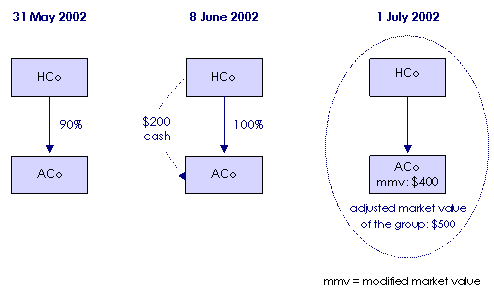Consolidation Reference Manual
You can still refer to the Consolidation reference manual for consolidation information that has not been impacted by changes in the legislation.
C3 Losses
C3-4 Worked example - loss utilisation
Calculating the available fraction
C3-4-120 Calculating an available fraction - losses transferred for the first time where there has been a pre-joining injection of capital
Description
The effect of certain pre-consolidation events that have increased a loss entity's market value - such as an injection of capital - are disregarded in calculating an available fraction.
This example shows how to treat an injection of capital into a loss entity prior to consolidation when calculating the entity's modified market value and the available fraction for loss bundles transferred for the first time from that entity.
- •
- loss bundles and calculating the available fraction → 'Treatment of losses', C3-1 ; 'Consolidation loss provisions', C3-2-110 (high-level worked example)
- •
- working out modified market value → 'Modified market value of a single joining entity', C3-4-110 (worked example)
- •
- working out the reduction amount for modified market value → 'Determining the reduction amount - subsection 707-325(3)', C3-6
Commentary
The utilisation of losses transferred to the head company of a consolidated group is subject to limits determined by reference to an available fraction, which is worked out separately for each loss bundle.
A loss bundle's available fraction is the proportion the joining loss entity's modified market value bears to the market value of the whole group when the bundle of losses is first transferred to a head company (called the 'initial transfer time').
The available fraction is calculated as:
modified market value of the loss entity / adjusted market value of the consolidated group
[F1]
Values are worked out as at the initial transfer time. As the calculation of an available fraction for a bundle is a crucial component of the rules for loss utilisation for consolidated groups, special rules are necessary to ensure the integrity of that calculation. These rules are designed to prevent the inflation of an available fraction resulting from certain events occurring prior to consolidation. → subsections 707-325(2) and (4), Income Tax Assessment Act 1997 .
For example, where a pre-consolidation injection of capital into the loss entity results in an increase in the value of the loss entity, that increase in value is excluded from the entity's modified market value (the numerator in the available fraction calculation). → Taxation Ruling TR 2004/9
The amount excluded is the lesser of:
- •
- the difference between the loss entity's modified market value at the joining time and what would have been its modified market value if the injection had not occurred, and
- •
- the total increase in the entity's market value that occurs immediately after the capital injection.
The rules prevent a loss entity from seeking to obtain a higher available fraction by inflating its market value before it joins a consolidated group. They apply to events that occur after 8 December 2000 and in the four years preceding the loss entity joining the group.
Example
Facts
ACo has been 90% owned by HCo since incorporation. On 1 June 2002, HCo acquires the remaining 10% membership interest. Assume that HCo injects an amount of $200 cash into ACo on 8 June 2002. The wholly-owned group then consolidates on 1 July 2002. This sequence of events is represented in
Figure 1: Sequence of events

Calculation
In calculating the modified market value of ACo, the anti-inflationary rule works to reduce its market value of $400 by $200, which represents the lesser of:
- •
- $200, which is the difference between the modified market value of ACo at the joining time ($400) and the modified market value of ACo had the capital injection not occurred ($200), and
- •
- $200, which is the increase in ACo's market value immediately after the capital injection.
Therefore, the modified market value of ACo, as adjusted to disregard the increase in market value as a result of the injection of capital, is $200 ($400 - $200).
As a result, the available fraction for ACo's loss bundle would be 0.400 ($200 / $500).
Thus, the injection of capital of $200 has been excluded from the numerator but is still reflected in the market value of the group.
References
Income Tax Assessment Act 1997, Subdivision 707-C; as amended by New Business Tax System (Consolidation) Act (No.1) 2002 (No. 68 of 2002), Schedule 1
Income Tax (Transitional Provisions) Act 1997, section 707-329; as amended by New Business Tax System (Consolidation) Act (No.1) 2002 (No. 68 of 2002), Schedule 2
Explanatory Memorandum to the New Business Tax System (Consolidation) Bill (No. 1) 2002, Chapter 8
History
Revision history
Section C3-4-120 first published 2 December 2002.
Further revisions are described below.
| Date | Amendment | Reason |
|---|---|---|
| 26.10.05 | References to reduction amount, p. 1 and new taxation ruling. | For clarification. |
Proposed changes to consolidation
Proposed changes to consolidation announced by the Government are not incorporated into the Consolidation reference manual until they become law. In the interim, information about such changes can be viewed at:
- •
- http://assistant.treasurer.gov.au (Assistant Treasurer's press releases)
- •
- www.treasury.gov.au (Treasury papers on refinements to the consolidation regime).
Current at 26 October 2005
The market value of the consolidated group as at the joining time, ignoring any losses and assuming a nil franking account balance.
